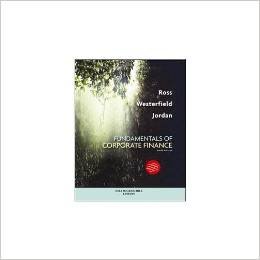
To calculate: The annual percentage rate and the effective annual rate of the two loans.
Introduction:
The annual rate that is earned from an investment or charged for borrowing is an annual percentage rate and it is also represented as APR. Thus, the APR is computed by multiplying the interest rate per period with the number of months in a year. The effective annual rate is the rate of interest that is expressed as if it were compounded once in a year.
Answer to Problem 64QP
The annual percentage rate is 5.50% and the effective annual rates for the two loans are 5.98% and 9.01%
Explanation of Solution
Given information:
An area has two banks, Bank I and Bank IMG. The banks offer a thirty year mortgage loan of $220,000 at 5.5%, and the banks charge an application fee of $3,500. The application fee that the Bank I charges is refundable if there is a denial for the loan application. The Bank IMG does not refund the application fee if the loan is denied.
The current disclosure law needs that any fee that is refundable for the rejection of the applicant will be included in calculating the annual percentage rate. However, this is not needed for the nonrefundable fees.
Note: First, it is necessary to calculate the annual percentage rate and the effective annual rate with the refundable fee. It is necessary to utilize the loan’s actual cash flow to determine the rate of interest. The actual application fee is $3,500 and so Person X has to borrow $223,500 to get $220,000 after the fee deduction.
Formula to calculate the
Note: C denotes the payments, r denotes the rate of exchange, and t denotes the period. The payment is found using the formulae of the present value of annuity.
Compute the present value annuity:
Hence, the payment C is $1,269.008.
Note: The r values is found using the calculated C amount in the equation of the present value of annuity and the original amount that has to be borrowed that is $223,500.
Formula to calculate the present value annuity:
Note: C denotes the payments, r denotes the rate of exchange, and t denotes the period.
Compute the present value annuity:
Note: To find the interest rate, it is necessary to solve the equation using a spreadsheet.
Compute the interest rate using the spreadsheet:
Step 1:
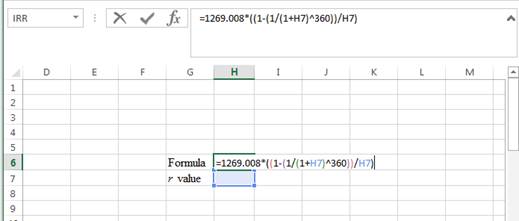
- Type the formula of the present value annuity in H6 in the spreadsheet and consider the r value as H7.
Step 2:
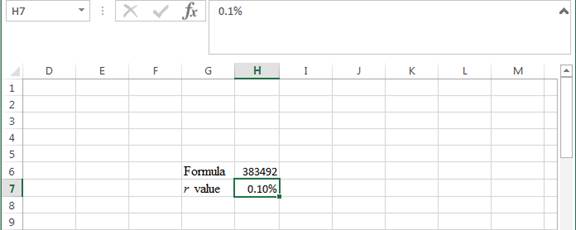
- Assume the r value as 0.10%.
Step 3:
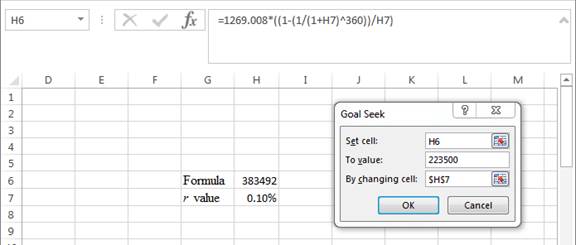
- In the spreadsheet, go to Data and select What-If-Analysis.
- Under What-If-Analysis tab, select Goal Seek.
- In set cell, select H6 (the formula).
- The ‘To value’ is considered as 223,500 (the value of the present value of annuity).
- The H7 cell is selected for the 'by changing cell'.
Step 4:
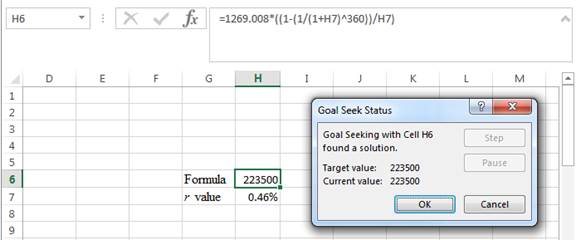
- Following the previous step, click OK in the Goal Seek Status. The Goal Seek Status appears with the r value.
Step 5:
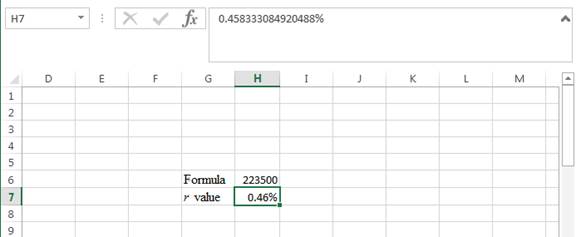
- The r value appears to be 0.458333084920488%.
Hence, the r value is 0.46%
Compute the annual percentage rate:
Note: The annual percentage rate is computed by multiplying the interest rate with the number of periods in a year.
Hence, the annual percentage rate is 5.50%.
Formula to calculate the effective annual rate:
Compute the effective annual rate:
Hence, the effective annual rate is 0.0598% or 5.98%.
Calculations for the nonrefundable fee:
Annual percentage rate is 5.5%
Note: The annual percentage rate for the nonrefundable fee is the quoted rate, as the fee is not considered as a part of the loan. The effective annual rate is computed with the help of the annual percentage rate.
Formula to calculate the effective annual rate:
Compute the effective annual rate:
Hence, the effective annual rate for the non-refundable fee is 0.901% or 9.01%.
Want to see more full solutions like this?
Chapter 6 Solutions
Fundamentals Of Corporate Finance, Tenth Standard Edition
- Dr Z. Mthembu is the owner of Mr Granite, a business in the Western Cape. After more than 28 years of operation, the business is thinking about taking on a new project that would provide a profitable new clientele. With only R1.5 million in resources, the company is now working on two competing projects. The starting costs for Project X and Project Y are R625,000 and R600000, respectively. These projected are estimated for the next 7 years timeframe. According to SARS, the tax rate is 28%, and a discount rate of 11.25% is applied.Projects X Project YProject X Project Y129000 145000154000 145000312000 145000168000 14500098250 14500088750 14500016050 145000arrow_forwardDr Z. Mthembu is the owner of Mr Granite, a business in the Western Cape. After more than 28 years of operation, the business is thinking about taking on a new project that would provide a profitable new clientele. With only R1.5 million in resources, the company is now working on two competing projects. The starting costs for Project X and Project Y are R625,000 and R600000, respectively. These projected are estimated for the next 7 years timeframe. According to SARS, the tax rate is 28%, and a discount rate of 11.25% is applied.Projects X Project YProject X Project Y129000 145000154000 145000312000 145000168000 14500098250 14500088750 14500016050 145000arrow_forwardDr Z. Mthembu is the owner of Mr Granite, a business in the Western Cape. After more than 28 years of operation, the business is thinking about taking on a new project that would provide a profitable new clientele. With only R1.5 million in resources, the company is now working on two competing projects. The starting costs for Project X and Project Y are R625,000 and R600000, respectively. These projected are estimated for the next 7 years timeframe. According to SARS, the tax rate is 28%, and a discount rate of 11.25% is applied.Projects X Project YProject X Project Y129000 145000154000 145000312000 145000168000 14500098250 14500088750 14500016050 145000arrow_forward
- Dr Z. Mthembu is the owner of Mr Granite, a business in the Western Cape. After more than 28 years of operation, the business is thinking about taking on a new project that would provide a profitable new clientele. With only R1.5 million in resources, the company is now working on two competing projects. The starting costs for Project X and Project Y are R625,000 and R600000, respectively. These projected are estimated for the next 7 years timeframe. According to SARS, the tax rate is 28%, and a discount rate of 11.25% is applied.Projects X Project YProject X Project Y129000 145000154000 145000312000 145000168000 14500098250 14500088750 14500016050 145000arrow_forwardAn investor buys 100 shares of a $40 stock that pays an annual cash dividend of $2 a share (a 5 percent dividend yield) and signs up for the DRIP. a. If neither the dividend nor the price changes, how many shares will the investor have at the end of 10 years? How much will the position in the stock be worth? Answer: 5.000 shares purchased in year 1 5.250 shares purchased in year 2 6.078 shares purchased in year 5 62.889 total shares purchased b. If the price of the stock rises by 6 percent annually but the dividend remains at $2 a share, how many shares are purchased each year for the next 10 years? How much is the total position worth at the end of 10 years? Answer: 4.717 shares purchased in year 1 4.592 shares in year 3 3.898 shares in year 10 Value of position: $10,280 c. If the price of the stock rises by 6 percent annually but the dividend rises by only 3 percent annually, how many shares are purchased each year for the next 10 years? How much is the total position worth at the…arrow_forwardDr Z. Mthembu is the owner of Mr Granite, a business in the Western Cape. After more than 28 years of operation, the business is thinking about taking on a new project that would provide a profitable new clientele. With only R1.5 million in resources, the company is now working on two competing projects. The starting costs for Project X and Project Y are R625,000 and R600000, respectively. These projected are estimated for the next 7 years timeframe. According to SARS, the tax rate is 28%, and a discount rate of 11.25% is applied.Projects X Project YProject X Project Y129000 145000154000 145000312000 145000168000 14500098250 14500088750 14500016050 145000 Calculate the IRR for the two proposed Projectsarrow_forward
- Your sibling want to go on a holiday in 7 years. The cost of a similar holiday today is R70,000 and the cost of the holiday increases by 5% per annum.If he/she can earn 11% per annum on a savings account, how much must he/she save per month as from today to have the money ready in 7 years time? Note: savings will be at the beginning of each month.arrow_forwardHow does corporate governance of a not-for-profit business vary from corporate governance of a traditional for profit business?Include references.arrow_forwardGiven the information below for HooYah! Corporation, compute the expected share price at the end of 2026 using price ratio analysis. Assume that the histor (arithmetic) average growth rates will remain the same for 2026. end of Year 2020 2021 2022 2023 2024 2025 Price $ 27.00 $ 63.50 $ 135.00 $ 212.00 $ 102.00 $ 32.50 EPS -7.00 -6.29 -2.30 -0.57 0.05 0.06 CFPS -18.00 -15.50 -3.30 -0.05 0.63 0.08 SPS 24.00 32.50 27.60 31.10 34.60 40.95 What is the expected share price at the end of 2026, using PE ratio? $110.45 $100.45 $120.45 $90.45 22 Multiple Choice Given the information below for HooYah! Corporation, compute the expected share price at the end of 2026 using price ratio analysis. Assume that the histor (arithmetic) average growth rates will remain the same for 2026. end of Year 2020 2021 2022 2023 2024 2025 Price $ 27.00 $ 63.50 $ 135.00 $ 212.00 $ 102.00 $ 32.50 EPS -7.00 -6.29 -2.30 -0.57 0.05 0.06 CFPS -18.00 -15.50 -3.30 -0.05 0.63 0.08 SPS 24.00 32.50 27.60 31.10 34.60 40.95…arrow_forward
- What is finance subject? how can this usefull with corporate finance?arrow_forwardwhat is corporate finance ? how this is added with finance. no aiarrow_forward(Annual percentage yield) Compute the cost of the following trade credit terms using the compounding formula, or effective annual rate. Note: Assume a 30-day month and 360-day year. a. 3/5, net 30 b. 3/15, net 45 c. 4/10, net 75 d. 3/15, net 45 ... a. When payment is made on the net due date, the APR of the credit terms of 3/5, net 30 is decimal places.) %. (Round to twoarrow_forward
 Essentials Of InvestmentsFinanceISBN:9781260013924Author:Bodie, Zvi, Kane, Alex, MARCUS, Alan J.Publisher:Mcgraw-hill Education,
Essentials Of InvestmentsFinanceISBN:9781260013924Author:Bodie, Zvi, Kane, Alex, MARCUS, Alan J.Publisher:Mcgraw-hill Education,

 Foundations Of FinanceFinanceISBN:9780134897264Author:KEOWN, Arthur J., Martin, John D., PETTY, J. WilliamPublisher:Pearson,
Foundations Of FinanceFinanceISBN:9780134897264Author:KEOWN, Arthur J., Martin, John D., PETTY, J. WilliamPublisher:Pearson, Fundamentals of Financial Management (MindTap Cou...FinanceISBN:9781337395250Author:Eugene F. Brigham, Joel F. HoustonPublisher:Cengage Learning
Fundamentals of Financial Management (MindTap Cou...FinanceISBN:9781337395250Author:Eugene F. Brigham, Joel F. HoustonPublisher:Cengage Learning Corporate Finance (The Mcgraw-hill/Irwin Series i...FinanceISBN:9780077861759Author:Stephen A. Ross Franco Modigliani Professor of Financial Economics Professor, Randolph W Westerfield Robert R. Dockson Deans Chair in Bus. Admin., Jeffrey Jaffe, Bradford D Jordan ProfessorPublisher:McGraw-Hill Education
Corporate Finance (The Mcgraw-hill/Irwin Series i...FinanceISBN:9780077861759Author:Stephen A. Ross Franco Modigliani Professor of Financial Economics Professor, Randolph W Westerfield Robert R. Dockson Deans Chair in Bus. Admin., Jeffrey Jaffe, Bradford D Jordan ProfessorPublisher:McGraw-Hill Education





